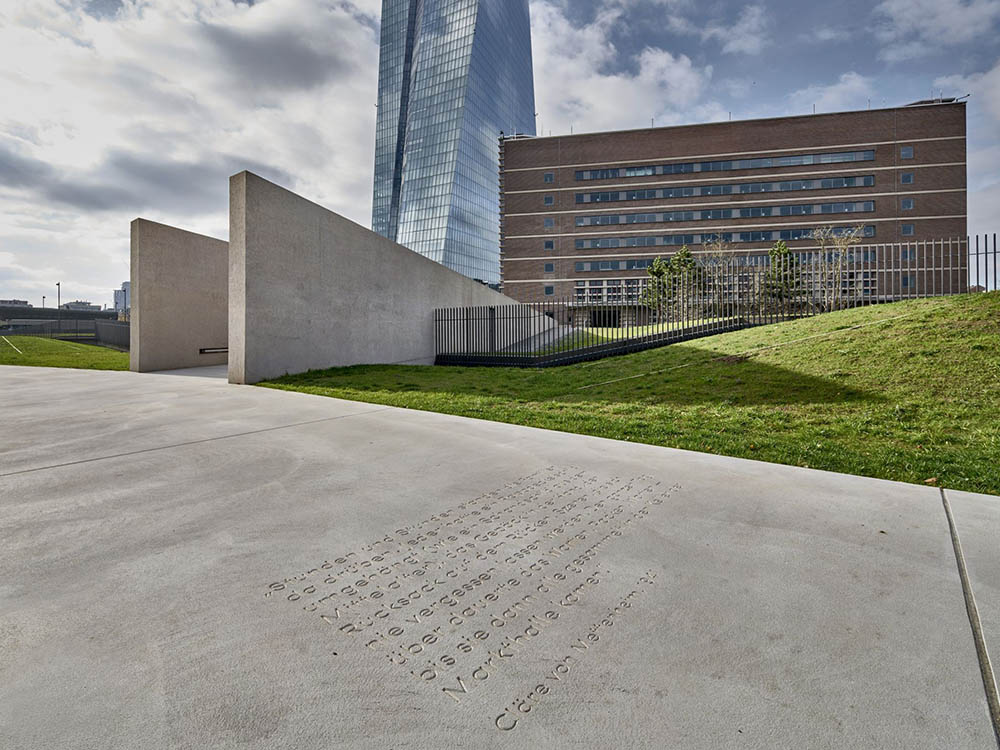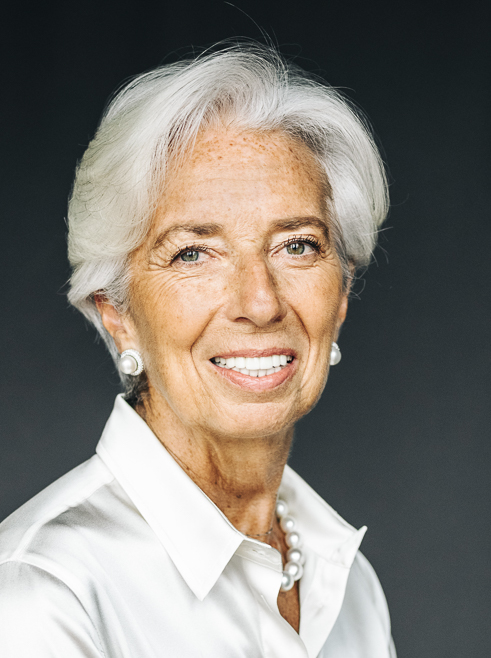- THE ECB BLOG
Remembering the Holocaust: we owe it to the victims and to ourselves
27 January 2023
The ECB’s main building in Frankfurt stands on a site linked to the atrocities of the Holocaust. On International Holocaust Remembrance Day, we affirm that tyranny and state injustice must never again prevail. Building European unity is a cornerstone of this commitment.
The ECB’s main building in Frankfurt occupies a historically significant site. It is one of the thousands of places in Germany and throughout Europe where the German Nazi regime set in motion the murder of millions of members of the Jewish community and other minorities. We commemorate the deportations and subsequent killings with a memorial, in cooperation with the City of Frankfurt and its Jewish Museum. Today, on 27 January 2023, the 78th anniversary of the liberation of the Auschwitz concentration and extermination camp, we are also unveiling a commemorative plaque at the entrance to the ECB’s main building.
During the Second World War all of Germany’s larger cities organised assembly points where Jewish citizens were rounded up and deported. In Frankfurt, this was the “Großmarkthalle”, the city’s wholesale market hall, which today is part of the ECB premises. In the cellars of the Großmarkthalle, Nazi officials humiliated and robbed more than 10,000 Jewish women, men and children, before forcing them onto trains headed for ghettos, concentration camps and extermination camps, to be murdered. Only a few survived.
Designed by architect Martin Elsaesser and completed in 1928, the Großmarkthalle was a particularly modern building, ahead of its time in many ways. Known locally as the “Gemieskirch” (vegetable church), fresh produce was sold to retailers here. Located in the middle of Frankfurt's Ostend area the Großmarkthalle has excellent transport links. I make this point because this building was chosen with care. The railway tracks leading to Theresienstadt, Łódź, Minsk, Kaunas, Izbica, Raasiku, Majdanek and Sobibór began here. A total of ten large transports to concentration and extermination camps left Frankfurt between October 1941 and September 1942. Until 15 March 1945 there were also several smaller deportations to Auschwitz, Buchenwald and Theresienstadt. Most of these smaller transports started from Frankfurt’s Main Station or from Frankfurt East, which is located close to the Großmarkthalle.
For this purpose, the Gestapo rented the basement of the Großmarkthalle for a few days from the City of Frankfurt, just long enough to conduct a deportation, while the sale of fruit and vegetables continued just above. The Großmarkthalle was in fact a very public place. The deportation of the Jews – like their disenfranchisement and oppression in the years before – did not happen in secret. The victims were often jeered at by passers-by on their way out of the city centre. Then, in the Großmarkthalle basement, the victims had to hand over their valuables and house keys, in just one of a string of demeaning steps in this humiliating process. Compounding the callousness of their ordeal, they even had to pay the train fare for their journey to the ghettos, concentration camps and extermination camps. They were then either herded directly onto trains or had to spend the night in the cellar, in appalling conditions. The memorial on and around the ECB premises retraces this horrific path of suffering.
Entrance to the Holocaust Memorial at the former Frankfurt Grossmarkthalle.

Source: Photo by Norbert Miguletz (Frankfurt) - Jüdisches Museum, Frankfurt am Main.
Today, as we unveil an additional memorial plaque, I had the privilege of meeting Edith Erbrich. When Edith was seven, the Nazis ordered her, together with her father and sister, to be deported. That was on 14 February 1945, less than three months before the end of the war, which is what saved her life. Her mother, who was not Jewish, was not allowed to accompany her family. Edith lost her grandfather in the camp, but her father and sister returned with her to her mother. They were the exception: out of more than 10,000 deportees, only a few survived. Yet, as deeply sad as this part of Edith’s story is, it is encouraging to know how her life continued. Edith stayed with her family in Frankfurt, worked here, married and led a full life. A few years ago, she started telling her story in schools and at public events. She has done so many times for us too, and I am proud and grateful to say that Edith Erbrich has become a friend of the ECB.
Why is remembering so important for us? We owe it to the victims, but we also owe it to ourselves. Tyranny and state injustice must not prevail. And yet they are still happening. Even today, some governments seek to impose their will by force, and they do not shy away from mass murder and genocide.
The fact that the ECB’s main building occupies a site which bore witness to such great suffering and atrocity adds poignancy and relevance to the ECB’s mission. Indeed, the European Union was founded in response to the Second World War and the Holocaust. It is, at its core, a peace project that aims to ensure we never inflict such horrors on each other again. This commitment finds its concrete expression in our efforts to build an ever-closer union in Europe that guarantees our political and economic stability. The ECB’s job of managing our common currency – the euro – is a key part of this.
The European Union is a peaceful community based on common values: the dignity of every person, the respect of human rights, freedom, democracy and the rule of law. And this is what we are, ultimately, working to uphold. It is our contribution to “never again”.
Subscribe to the ECB blog


